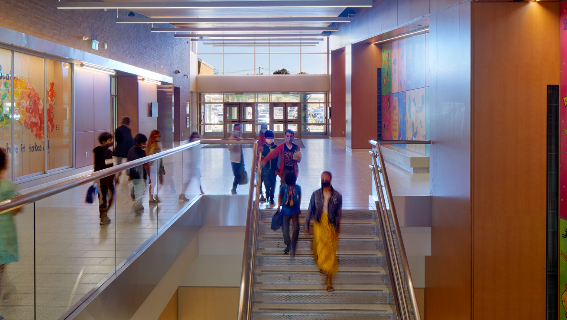USGBC webcasts will help schools access federal funding for efficiency projects

The federal funding series kicked off with an information-packed session on June 29.

In the first of four webcasts about federal funding for school buildings, the Center for Green Schools and The School Superintendents Association (AASA) hosted a large panel of experts that laid the groundwork for those wanting to learn more about how to access funds.
Over 400 people signed up to join the June 29 session to hear speakers give an overview of opportunities, explain where to look for updates and information, describe available tax incentives, and summarize how financing can be leveraged and maximized.
Topics for the June 29 session were grouped into three parts for the webcast, highlighted below.
Part I
To kick off the session, the Center’s director, Anisa Heming, gave an overview of recent federal legislation and the specific provisions that have allocated funding for or could direct funding toward school buildings.
Harley Stokes of BlueGreen Alliance built on this overview by explaining the biggest opportunities for schools. She also gave an overview of equity and labor provisions in recent legislation.
Part II
The session then turned to where attendees can find more information. BlueGreen Alliance’s guides for the Infrastructure Investment and Jobs Act and the Inflation Reduction Act (IRA) were highlighted, as were resources from USGBC on the bills’ contents.
Grace Smith of the Environmental Defense Fund (EDF) gave attendees a walk-through of the IRA tracker that EDF and Columbia University created to collect provisions of the IRA and publish information when agencies have acted to propose guidelines or implement provisions.
Ben Searle of the U.S. Department of Labor rounded out this portion of the webcast with an explanation of the Davis-Bacon prevailing wage requirements, when they apply to projects, and how to find more information.
Part III
The third part of the session focused on tax incentives available for school building projects. Ramon Reynoso of Ernst and Young gave a high-level overview of the clean energy investment tax credits and the alternative-fuel vehicle refueling property tax credit, both of which are available for direct pay to entities such as school districts.
Will Volker of Efficiency Energy followed with information about the 179D commercial buildings energy-efficiency tax deduction, which can lower costs for school building projects when leveraged effectively by building owners.
Both Volker and Reynoso will be joining the next two webcasts in the series to delve further into the details of these tax incentives.
Finally, Tim Unruh of the National Association of Energy Services Companies addressed the final topic of the session: leveraging available funding. He explained how available funding can be maximized by investing in projects that pay themselves back in energy savings. He further described how those energy savings and available federal funding can be financed into the cost of the projects from the beginning. Unruh will also be joining future sessions to ensure further discussion of this concept.
The three remaining sessions in the series are targeted toward answering specific questions from attendees, reflecting just how quickly knowledge about federal funding opportunities evolves in the field. The team from the center gathered questions from attendees and continues to accept questions via email.
The federal funding for school buildings series is generously supported by Schneider Electric. Support is also provided by Shaw Contract through their sponsorship of the Center’s work to increase knowledge of green design and construction among school district capital planning staff.
Access the recording and notes from The Fundamentals of Federal Funding for School Buildings at USGBC.
